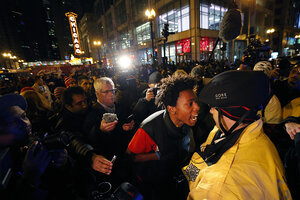Illinois attorney general calls for federal probe into Chicago police department
In the eyes of activists, many of whom believe the kind of cover up suggested in this case is indicative of the general climate within the Chicago police, sweeping investigations are the only way to root out systemic bias and corruption.

Lamon Reccord, second from right, yells at a Chicago police officer 'Shoot me 16 times' as he and others march through Chicago's Loop Wednesday, Nov. 25, one day after murder charges were brought against police officer Jason Van Dyke in the killing of 17-year-old Laquan McDonald, in Chicago.
Charles Rex Arbogast/AP
The US Department of Justice has been asked to investigate the Chicago Police Department following the release of dash cam videos more than a year after the fatal shooting of a black teenager by a white Chicago police officer. Many speculate that police officials “dragged their feet on the investigation” and possibly attempted to “cover up what happened,” a crime that could result in 20-year sentences for those found guilty.
On Tuesday, Illinois Attorney General Lisa Madigan filed the request citing that the police department violated federal law, signaling a need to investigate the department’s “use of deadly force and whether a pattern or practice of discriminatory policing exists.” In the eyes of activists, many of whom believe the kind of cover up suggested in this case is indicative of the general climate within the Chicago police, sweeping investigations are the only way to root out systemic bias and corruption.
The amount of speculation of continued coverup even following the release of the video of Laquan McDonald's death shows how deeply the rupture of trust cuts.
Last week, Chicago police officials released videos from four squad cars that depicted the Oct. 20, 2014 scene when police officer Jason Van Dyke shot the teenager 16 times.
The footage contradicts police officials' initial accounts that Laquan approached the officers while visibly armed, and lunged before he was killed by a single shot.
Several officers were on the scene and only Mr. Van Dyke fired his weapon. He began shooting less than a minute after arriving at the scene and just six seconds after getting out of his car, according to Cook County State’s Attorney Anita Alvarez.
All four of the videos are also void of audio, though Chicago police cars are setup to record audio along with video. Police spokesman Anthony Guglielmi attributes this to “software issues” or “operator error,” but Ed Primeau, an audio and video forensics expert, told the Associated Press, “It’s a red flag. I see it all the time – not just by police but by people trying to cover things up.”
Furthermore, a district manager of the Burger King near the scene of the shooting told reporters that an hour and a half of surveillance footage was erased from his restaurant cameras after police officers went through the footage. However, a police review board spokesman said there was “no credible evidence,” to assert such a claim.
Ms. Alvarez approved a murder charge for Van Dyke on Nov. 24, but he was released from county jail Monday after posting ten percent of the $1.5 million bail. Alvarez now faces pressure to resign amid “criticism that it took her office 13 months to file the murder charges against Van Dyke,” reported USA Today.
Further investigations are underway to determine if Van Dyke violated Laquan’s civil rights. If found guilty, Van Dyke could face a maximum life sentence.
This report contains material from the Associated Press.

